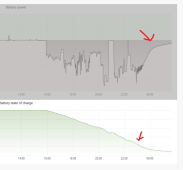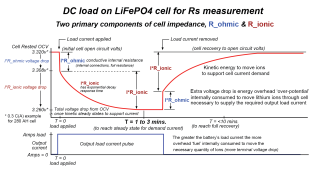So I've been trying to figure out the behavior of these lifepo4 batteries. 1-2-3 were purchased 3 months apart from 4-5-6. I've tried peak charging them to top the cells off but that had zero effect on the discharge. They can at times show a 12% soc variation between the top 3 and bottom 3 packs with different discharge wattages. I read that this is normal behavior but to me it seems odd that the packs that were purchased at the same time act the same?
I'm guessing it has something to do with internal resistances between the manufactured cells? I updated the firmware on all 6 packs to be the same. no luck. I even set it up to be closed loop with the sol ark 12k and they behaved the same.
Also when the packs drop below an average of 25% soc, they start to cut back on discharge rates. This is while on grid with work schedule active. Is this the sol ark doing this or the battery bms? I temporarily disabled the close loop and connected the batteries to solar assistant to get more info. Seems odd that the top 3 have pretty much stopped discharging. Could this be due to cells not being balanced? I don't normally discharge below 50% on any normal day with tou. I wanted to discharge them to see if that would have any effect on the balancing in question
picture 2 red = grid power, blue = load
picture 3 top arrow = curve which battery cutts power, bottom arrow = 25% soc
I saw will had a video on the eg4 racks and he mounted the negative to the bottom of the rack to help eliminate "current sharing problems" Could this behavior be that?
I'm guessing it has something to do with internal resistances between the manufactured cells? I updated the firmware on all 6 packs to be the same. no luck. I even set it up to be closed loop with the sol ark 12k and they behaved the same.
Also when the packs drop below an average of 25% soc, they start to cut back on discharge rates. This is while on grid with work schedule active. Is this the sol ark doing this or the battery bms? I temporarily disabled the close loop and connected the batteries to solar assistant to get more info. Seems odd that the top 3 have pretty much stopped discharging. Could this be due to cells not being balanced? I don't normally discharge below 50% on any normal day with tou. I wanted to discharge them to see if that would have any effect on the balancing in question
picture 2 red = grid power, blue = load
picture 3 top arrow = curve which battery cutts power, bottom arrow = 25% soc
I saw will had a video on the eg4 racks and he mounted the negative to the bottom of the rack to help eliminate "current sharing problems" Could this behavior be that?









